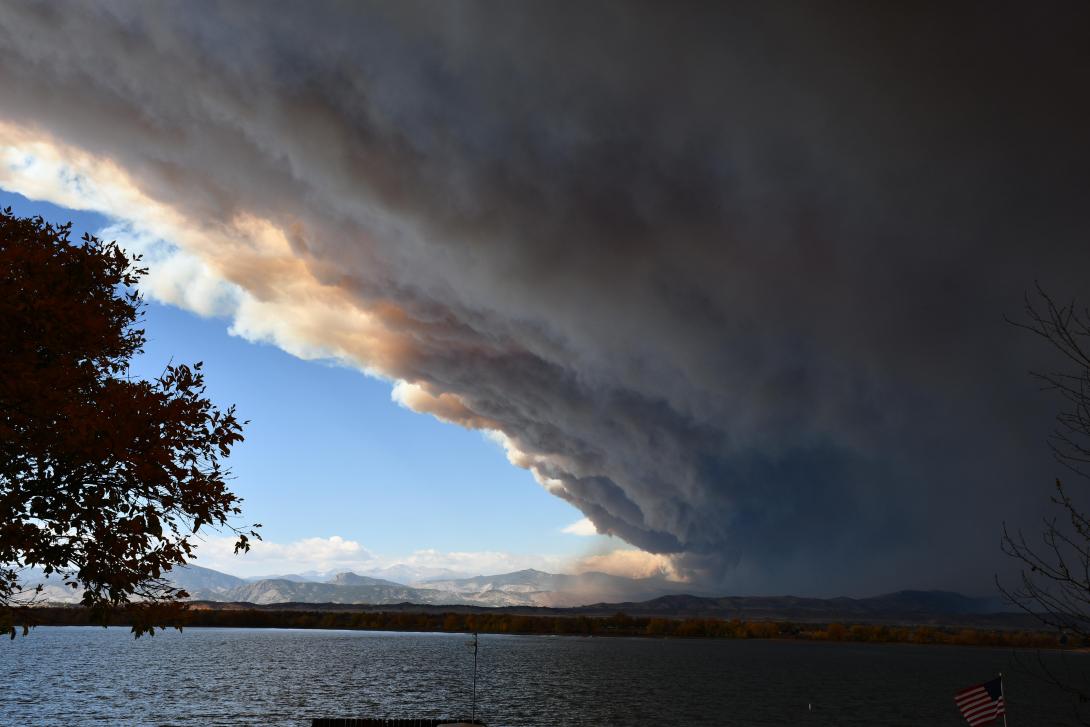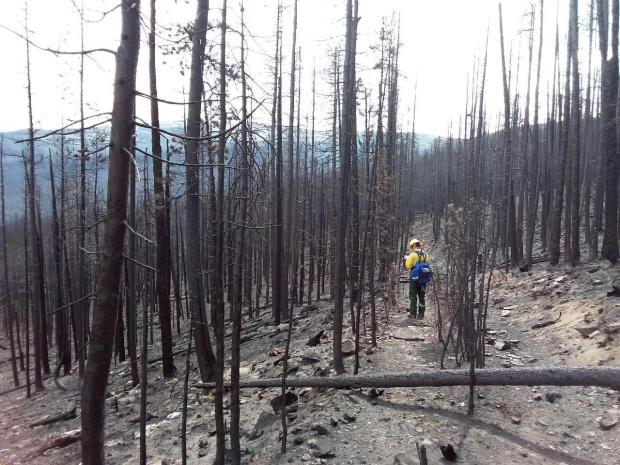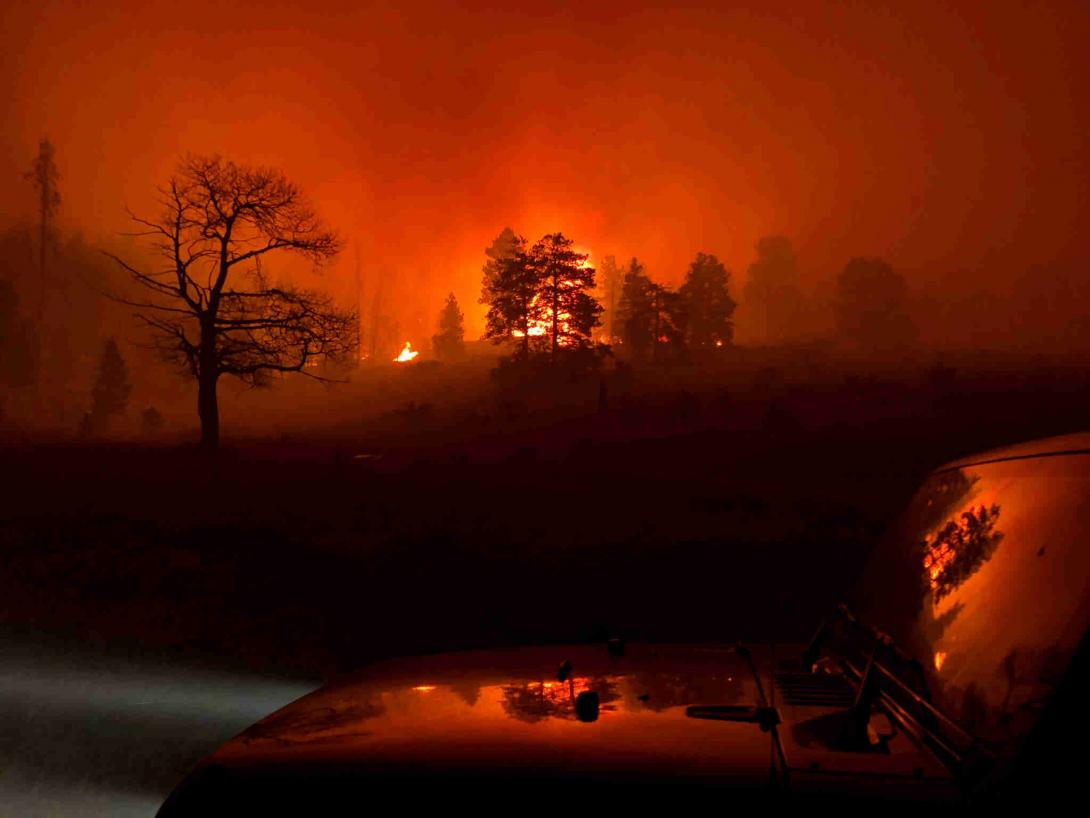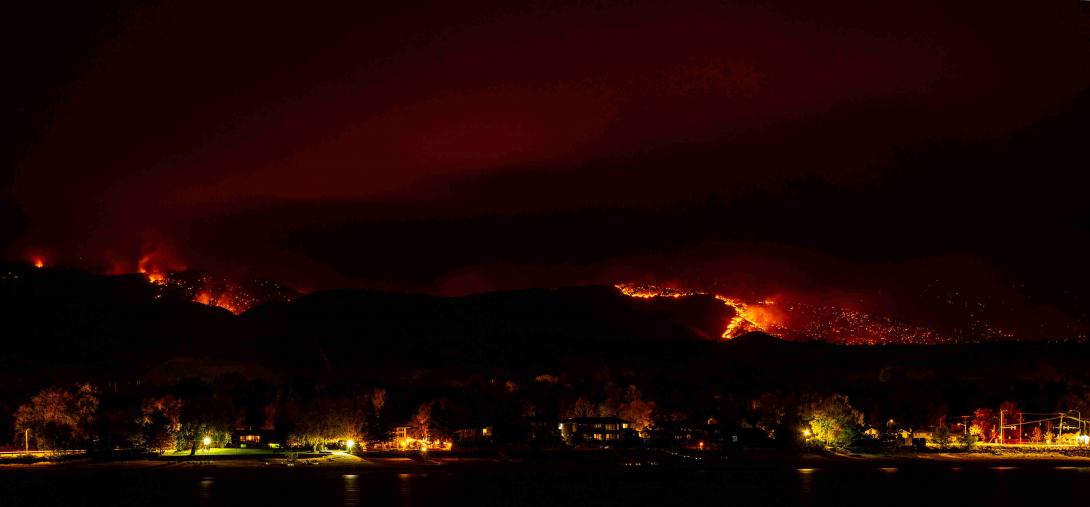Cameron Peak Fire
Full Article
The Cameron Peak Fire is the largest wildfire in Colorado history. It began on August 13, 2020, and burned 208,913 acres of the Arapaho and Roosevelt National Forests in western Larimer County. Thought to be human-caused, the fire ignited on the flanks of Cameron Peak some forty miles west of Fort Collins. After staying under 25,000 acres for three weeks, persistent dry conditions and high winds caused two major blowups—one on Labor Day weekend, when the fire ran some 80,000 acres, and another on October 14-17, when it made a 30,000-acre run toward Fort Collins followed by a 25,000-acre run toward the Big Thompson Canyon and Estes Park.
Although no one died, the fire burned some 469 structures, including 224 houses, and forced thousands of evacuations. For three months, the Cameron Peak Fire created toxic air quality along the Front Range from Greeley to Denver. The fire’s effects on the Cache la Poudre watershed are yet to be determined, but it is clear that forest and community recovery will likely take many years.
2020 Fire Season
Colorado’s 2020 fire season got off to a late but busy start. Parts of the state saw decent precipitation levels earlier that summer, but things abruptly dried out in late July and early August, when several fires ignited. The Pine Gulch Fire broke out north of Grand Junction on July 31 and went on to break the record for the state’s largest fire, while the Grizzly Creek Fire near Glenwood Springs started on August 10 and shut down Interstate 70 for weeks. In Grand County, the Williams Fork Fire started the day after the Cameron Peak Fire, and its smoke plume was visible from I-70 for two months.
Meanwhile, Fort Collins was experiencing record heat in August. The city’s average high temperature in August is 86 degrees Fahrenheit; in August 2020, it saw seventeen straight days above 90 degrees, including two that reached 100 degrees. In the mountains west of Fort Collins, low humidity, weeks of dry weather, and miles of accumulated fuels near Cameron Pass made for dangerous fire conditions.
Ignition
On August 13, Korey Buck was hiking in the Rawah Wilderness near Cameron Pass when he noticed a thick, black smoke cloud rising above the lodgepole crowns. He immediately reported the fire, which was burning on the east side of Cameron Peak, northwest of Rocky Mountain National Park, at 10,000 feet of elevation. Steep terrain and hot, windy conditions prevented early intervention by fire crews, who settled for digging out lines and protecting property several miles away from the blaze.
By August 15, the fire had grown to 15,000 acres in the Arapaho and Roosevelt National Forests, with zero percent containment. The fire was hemmed in by treeless alpine tundra to the west, and it was burning in such a remote area that incident commanders focused on shoring up the dozens of small cabins, resorts, and private residences along State Highway 14 in the Poudre Canyon. Air quality in Fort Collins varied with wind direction, but on some days, hot temperatures combined with high smoke and particulate levels to make it dangerous to go outdoors.
Explosion
By the end of August, the fire seemed content clinging to the flanks of Cameron Peak, slowly growing to about 26,000 acres. Cooler weather and a slight increase in precipitation at the end of August provided some optimism for containment, which stood at only 4 percent. On August 31, one incident commander expressed hope that fall weather might provide some assistance. “We hope there’s more rain,” he said. “We hope it snows on this fire.” Still, he was concerned about the area’s Chinook winds—dry, hot winds that race down the eastern slope of the Rockies after the mountains wring all the moisture out of large fronts from the Pacific. With Chinook winds in the forecast, crews watched an approaching Labor Day heat wave with grave concern.
On September 5, temperatures in Fort Collins shot up to 100 degrees, and the Cameron Pass area was under a red flag warning. The fire responded in kind, exploding to nearly 60,000 acres by September 6, then racing to more than 100,000 acres the next day. Ash rained from the sky in Fort Collins that Labor Day, as more than 800 firefighters battled the blaze under the orange and smoke-darkened skies to the west. The fire burned through twenty-five houses and forced rapid evacuations as it marched east toward more populated areas such as Red Feather Lakes and Horsetooth Reservoir. Complicating matters was an outbreak of coronavirus among firefighters, which put several crew members in quarantine and required an extra level of careful coordination to avoid spreading the disease.
From Fire to Frost
On Labor Day evening, crew leaders’ prayers for snow were answered. An early-season winter storm was expected overnight, and fire chiefs anxiously watched the clock in hopes that the blizzard would halt the Cameron Peak Fire’s relentless advance. In a record swing, temperatures plummeted some fifty-seven degrees in Fort Collins that night, landing at 38 degrees the next morning. The storm dumped about sixteen inches of snow on the fire, pausing its advance at 102,500 acres. By that point the cost of fighting the fire had already ballooned to more than $16 million.
The snow dampened but did not douse the fire, and the blaze slowly resumed its advance when dry conditions returned a week later. By September 11, the fire was still only 4 percent contained, but crews had taken the opportunity provided by the snowstorm to reinforce existing lines and put out smoldering hot spots, hoping to check the fire’s spread.
Battle for Containment
Weather conditions held steady through the end of September. Warm temperatures, sustained winds, and little rain made it difficult for crews to gain containment on the Cameron Peak Fire. Additional resources arrived on September 23, and they were timely—the fire had grown to 104,791 acres and forced mandatory evacuation orders to be re-issued for the Crystal Lakes and Red Feather Lakes areas. Now numbering close to 1,000, crews had achieved 27 percent containment by September 24, but the next day brought more anxiety, as gusty winds pushed the northern “thumb” of the fire within three miles of Red Feather Lakes.
Colder temperatures arrived in early October, but dry winds and sunny skies persisted, driving fire activity. By the first weekend of October, crews had the Cameron Peak Fire 40 percent contained at just over 125,000 acres.
Record-Breaking Run
Through mid-October, the Cameron Peak Fire grew slowly but steadily as crews extended and fortified their fire lines, reaching beyond 50 percent containment on the 134,000-acre blaze. But with windy conditions and little if any moisture in the forecast, a blowup seemed imminent. The Type I Incident Command Team, the highest-level federal fire response unit, took control of the fire on October 14. That day, gusts up to 76 miles per hour blew the fire directly east across some 30,000 acres toward Fort Collins. With its second major run, the Cameron Peak Fire became the largest wildfire in Colorado history at 164,140 acres.
Again, Fort Collins was shrouded in an eerie midday darkness, with toxic air and raining ash. Hikers at Horsetooth Mountain Park, about fifteen miles east of the fire, were evacuated, and mandatory evacuations were ordered for Masonville and communities around Horsetooth Reservoir, a few miles west of the city.
Two days later, the fire went on another run, this time to the south toward US Highway 34 in the Big Thompson Canyon. Communities to the north and south of the highway were issued voluntary evacuation orders. By the end of the day on October 16, the blaze stood at 173,536 acres, gaining some 10,000 acres in one day.
In addition to the fire, crews still had to battle the coronavirus, as forty-two staff assigned to the Cameron Peak Fire had contracted the disease.
Another early-season snowstorm hit the Cameron Peak Fire area on October 24-25, dumping up to twenty-seven inches of snow on the blaze. This time, lower temperatures kept the snow from melting too fast, allowing crews to make significant gains on containment. By the end of October, the Cameron Peak Fire stood at 208,663 acres and 64 percent containment. Colder temperatures and more snowfall over the next two weeks helped crews get the fire beyond 90 percent containment by November 12. Containment finally reached 100 percent on December 3.
Aftermath
In mid-December 2020, the report of the Cameron Peak Fire Burned Area Emergency Response team noted that post-fire risks to the upper Poudre watershed would "persist for a decade or longer" and included "debris-laden flash floods in response to high-intensity rain events." In July 2021, one such rain event occurred, resulting in flash flooding that killed at least one person and swept away several homes.
Legacy
Along with the East Troublesome Fire and the devastating West Coast fires of 2020, the Cameron Peak Fire reflects the new realities of a warming climate in the American West, as well as the consequences of decades of fire suppression by the nation’s forest managers. A spike in temperatures in late July and early August rapidly dried out fuels that had built up for decades in the national forests that burned. Meanwhile, increased evaporation from hotter temperatures over the Pacific contributed to the early-season blizzard that hit Colorado after Labor Day—an example of climate change helping a fire situation instead of making it worse.
Spurred by the changing climate, record-breaking fires have become the norm in twenty-first century Colorado, and communities such as Fort Collins, as well as recreators on public lands, must prepare for an increased likelihood of such conflagrations in the future.































